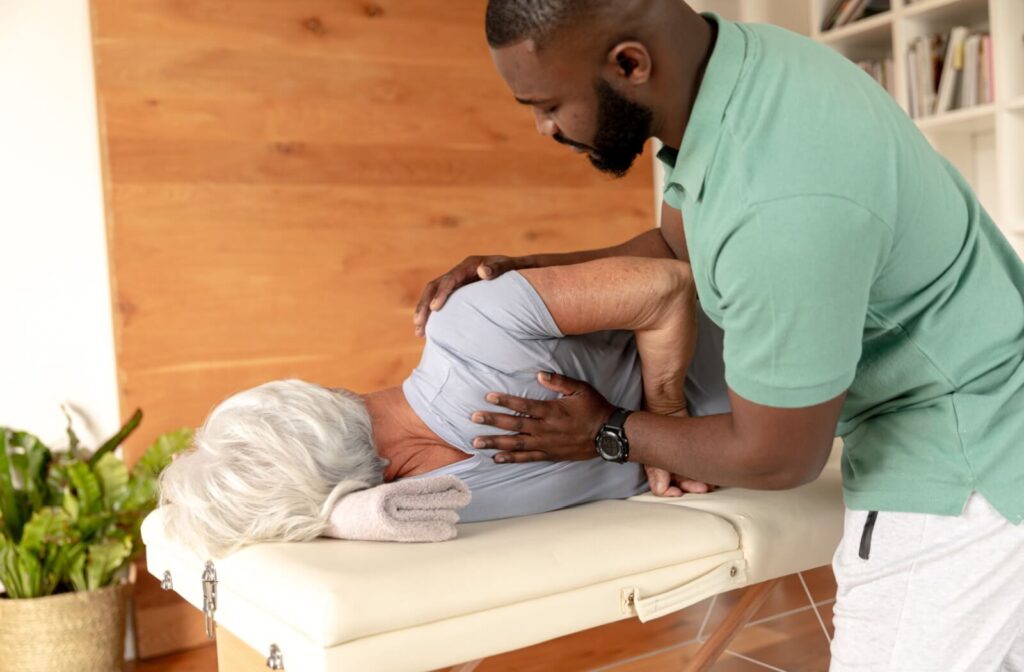Chronic pain isn’t merely about discomfort; it’s a daily challenge that affects how people live their lives. For seniors in particular, chronic pain can impact mobility, mental health, and quality of daily life.
Thankfully, noninvasive methods like massage therapy are becoming increasingly recognized for their ability to alleviate symptoms, even among older adults.
Gentle techniques, like Swedish massage or reflexology, can help older adults manage chronic pain, stimulate blood flow, reduce inflammation, and promote relaxation.
At the right community, massages can be offered as part of wellness offerings. Take advantage of your community’s wellness offerings today!
What Is Chronic Pain & How Does It Affect Seniors?
Chronic pain refers to pain that persists for longer than 3 months, even after the underlying issue has healed. For seniors, chronic pain often involves conditions like arthritis, sciatica, or fibromyalgia.
The effects of such pain go beyond the physical. It can reduce mobility, making it harder to engage in everyday activities. Pain may disrupt sleep, cause irritability, and result in feelings of isolation or depression.
Chronic pain can rob people of their independence, which can be especially distressing for seniors who’ve always valued living life on their own terms.
What Treatments Are Available for Chronic Pain?
Personalized, tailored treatment for managing chronic pain benefits from a multi-faceted approach:
- Prescription medications, like pain relievers or anti-inflammatory drugs, can help minimize symptoms, though these often carry risk, particularly for long-term use
- Physical therapy can work on improving strength, flexibility, & mobility
- Acupuncture can target specific pressure points to alleviate discomfort
- Lifestyle changes, including adopting a healthy diet, engaging in low-impact activities, & prioritizing rest, can help support overall health & comfort
- Massage therapy addresses both physical & mental well-being
How Does Massage Help with Chronic Pain?
Massage therapy is a holistic approach to health and wellness that involves manipulating the body’s soft tissues, including muscles, connective tissue, tendons, ligaments, and skin.
Through various techniques such as kneading, tapping, and stroking, massage therapists apply pressure to the body to help relieve tension, improve circulation, enhance relaxation, and support the healing of injuries.
Massage can be used for a wide range of purposes, from reducing physical pain and improving mobility to promoting emotional balance and stress relief. For seniors living with chronic pain, it provides 3 essential benefits: pain relief, stress reduction, and enhanced mobility.
1. Pain Relief
Massage manipulates soft tissues and muscles, reducing tension and alleviating sources of pain. Additionally, it stimulates the release of endorphins, the body’s natural “feel-good” chemicals, which can help diminish discomfort associated with pain signals.
2. Stress Reduction
Pain doesn’t just take a toll on the body; it can also weigh heavily on the mind. Massage therapy helps reduce stress hormones such as cortisol, giving recipients an improved sense of calm and control.
3. Enhanced Mobility
Over time, chronic pain causes stiffness in joints and muscles. Targeting these key areas through massage helps enhance circulation and flexibility, ultimately leading to improved mobility for seniors who want to regain freedom of movement.
Massage & Its Role in Reducing Bodywide Inflammation
Inflammation often exacerbates chronic pain, especially in older adults. Conditions such as rheumatoid arthritis and osteoarthritis stem from inflamed joints and tissues. Luckily, massage can directly counteract these effects.
Certain massage techniques can help stimulate lymphatic drainage, flushing toxins and inflammatory cells from the body. Increased blood circulation replenishes oxygen and nutrients in those problem areas, speeding up the healing process.
Over time, the reduction in inflammation directly translates to lower pain levels.
Is Massage Dangerous for Seniors?
When performed by a certified, experienced massage therapist, massage therapy is safe for most seniors. That said, older adults should take proper care to address pre-existing conditions.
For example, individuals with certain medical conditions, such as osteoporosis, deep vein thrombosis (DVT), or severe skin disorders, may need to avoid deep tissue massage or other high-pressure techniques.
Always choose a therapist with expertise in geriatric massage. They’ll understand how to tailor their approach to the unique needs of older adults, promoting safety and comfort.

What Type of Massage Is Best for Chronic Pain?
Choosing the right type of massage for chronic pain is crucial. Depending on your comfort level, sensitivity, and age, your massage therapist may use several different modalities to customize your treatment plan. Here are the most common methods for managing chronic pain.
1. Swedish Massage
Swedish massage is ideal for people new to massage therapy. It’s a gentle yet effective form of massage. The method uses long, gliding strokes to enhance circulation and promote relaxation, avoiding excessive pressure on sensitive joints.
2. Deep Tissue Massage
For individuals experiencing long-lasting muscle tension, deep tissue massage targets the underlying knots and adhesions in muscles and connective tissues. While it can be a bit more intense, its impact is undeniable for managing chronic pain.
3. Trigger Point Therapy
If chronic pain seems to radiate or shoot out from a specific spot, trigger point therapy might be the ideal choice. Therapists apply focused pressure on these “problem zones” to release tension and reduce referred pain.
4. Myofascial Release
Myofascial release helps ease stiffness and chronic pain, especially for those with fibromyalgia. The technique involves gently stretching and softening the fascia, the connective tissue surrounding muscles.
5. Reflexology
For seniors hesitant about full-body massage, reflexology can target specific pressure points in the hands and feet that correspond with other parts of the body. The gentle approach can bring relief while remaining noninvasive and comfortable.
Elevate Your Wellness Routine with Massage Therapy
Chronic pain doesn’t have to be a permanent part of life, especially for seniors who aim to maintain their freedom, mobility, and vitality.
Massage therapy is more than just temporary relief; it’s a step toward achieving an active and fulfilling lifestyle, a key component of All American Assisted Living at Hillsborough.
If you or a loved one is living with chronic pain, consider speaking with a licensed massage therapist to explore the styles and techniques suited to your specific needs.
With the proper care, you’ll experience less pain and greater freedom to enjoy life’s simple pleasures once again.





